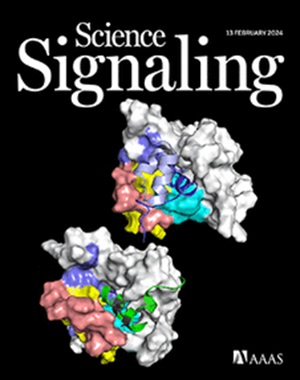Antigen receptor ITAMs provide tonic signaling by acting as guanine nucleotide exchange factors to directly activate R-RAS2
IF 6.7
1区 生物学
Q1 BIOCHEMISTRY & MOLECULAR BIOLOGY
引用次数: 0
Abstract
The small GTPase R-RAS2 regulates homeostatic proliferation and survival of T and B lymphocytes and, when present in high amounts, drives the development of B cell chronic lymphocytic leukemia. In normal and leukemic lymphocytes, R-RAS2 constitutively binds to antigen receptors through their immunoreceptor tyrosine-based activation motifs (ITAMs) and promotes tonic activation of the phosphatidylinositol 3-kinase (PI3K) signaling pathway. Here, we examined the molecular mechanisms underlying this direct interaction and its consequences for R-RAS2 activity. R-RAS2 exhibited direct, high-affinity interactions with ITAM peptides derived from B and T cell receptors through a proline-rich sequence in the hypervariable domain of R-RAS2. In resting T and B cells, the presence of antigen receptors at the plasma membrane was sufficient to promote the activation of R-RAS2 and PI3K, and mutations that abolished the interaction of R-RAS2 with ITAMs reduced R-RAS2 signaling. Binding to ITAMs increased GDP-GTP exchange on R-RAS2 through a mechanism distinct from that by which conventional cytosolic guanosine nucleotide exchange factors (GEFs) activate RAS proteins. These results define antigen receptors as noncanonical GEFs involved in the basal activation state of R-RAS2 in lymphocytes. Such a mechanism may underlie the leukemic transformation of B cells that occurs when wild-type R-RAS2 is present in high amounts.
求助全文
约1分钟内获得全文
求助全文
来源期刊

Science Signaling
BIOCHEMISTRY & MOLECULAR BIOLOGY-CELL BIOLOGY
CiteScore
9.50
自引率
0.00%
发文量
148
审稿时长
3-8 weeks
期刊介绍:
"Science Signaling" is a reputable, peer-reviewed journal dedicated to the exploration of cell communication mechanisms, offering a comprehensive view of the intricate processes that govern cellular regulation. This journal, published weekly online by the American Association for the Advancement of Science (AAAS), is a go-to resource for the latest research in cell signaling and its various facets.
The journal's scope encompasses a broad range of topics, including the study of signaling networks, synthetic biology, systems biology, and the application of these findings in drug discovery. It also delves into the computational and modeling aspects of regulatory pathways, providing insights into how cells communicate and respond to their environment.
In addition to publishing full-length articles that report on groundbreaking research, "Science Signaling" also features reviews that synthesize current knowledge in the field, focus articles that highlight specific areas of interest, and editor-written highlights that draw attention to particularly significant studies. This mix of content ensures that the journal serves as a valuable resource for both researchers and professionals looking to stay abreast of the latest advancements in cell communication science.
 求助内容:
求助内容: 应助结果提醒方式:
应助结果提醒方式:


